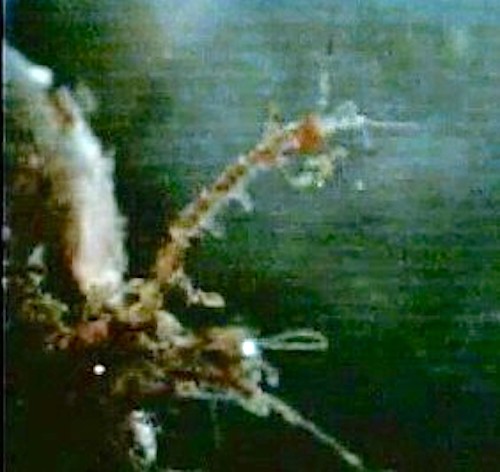We found these Caprellids at a depth of 20 metres attached to hydroids on a Balanus nubilus. They frequently dwell amongst hydroids. The size of this individual was 3mm. These individuals were photographed using a Motic Digital Microscope at 10X magnification. Note the response to stimulation by a dull probe.
In the picture below , the current meter float which was in the water for a year, came up covered with Caprellids. See this file on the Current meter:

Look closely to see these tiny skeleton shrimp clinging to bryozoans, hydroids or algae. Their body shape and color help the shrimp to blend into their background. Their bodies are long, cylindrical and range from pale brown and green to rose. Some species can quickly change color to blend into their backgrounds.
Skeleton shrimp look like, and sometimes are called, “praying mantises of the sea.” They have two pairs of legs attached to the front end of their bodies, with three pairs of legs at the back end. The front legs form powerful “claws” for defense, grooming and capturing food. The rear legs have strong claws that grasp and hold on to algae or other surfaces. They use their antennae for filter feeding and swimming.
Diet
diatoms (microscopic plants), detritus, filtered food particles, amphipods
Size
to 1.5 inches (4 cm) long
Range
low intertidal zone and subtidal waters in bays,

Conservation Notes
Skeleton shrimp are abundant and live in many habitats, including the deep sea. They play an important role in the ecosystem by eating up detritus and other food particles.
Cool Facts
Shrimp, sea anemones and surf perch prey on skeleton shrimp. The females of some skeleton shrimp species kill the male after mating.
Skeleton shrimp use their front legs for locomotion. To move, they grasp first with those front legs and then with their back legs, in inchworm fashion. They swim by rapidly bending and straightening their bodies.
To grow, skeleton shrimp shed their old exoskeletons and form new, larger ones. They can mate only when the female is between new, hardened exoskeletons. After mating, the female deposits her eggs in a brood pouch formed from leaflike projections on the middle part of her body. Skeleton shrimp hatch directly into juvenile adults.
Source: Monterey Bay Aquarium:
Online Field Guide http://www.mbayaq.org/efc/living_species/default.asp?hOri=1&inhab=521
Other Members of the Phylum Arthropoda at Race Rocks.
 The Race Rocks taxonomy is a collaborative venture originally started with the Biology and Environmental Systems students of Lester Pearson College UWC. It now also has contributions added by Faculty, Staff, Volunteers and Observers on the remote control webcams.
This file was originally started by Kevin Mwenda PC Yr 31 The Race Rocks taxonomy is a collaborative venture originally started with the Biology and Environmental Systems students of Lester Pearson College UWC. It now also has contributions added by Faculty, Staff, Volunteers and Observers on the remote control webcams.
This file was originally started by Kevin Mwenda PC Yr 31 |






